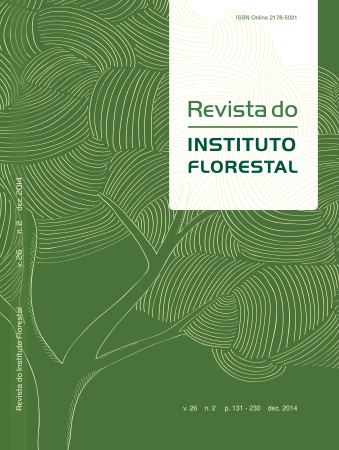GENETIC VARIATION IN THE LEVELS OF MACRO AND MICRONUTRIENTS AFTER 2,4-D APPLICATION ON Eucalyptus grandis PROGENIES
DOI:
https://doi.org/10.4322/rif.2014.012Keywords:
auxin, genetic parameters, metabolism, mineral nutritionAbstract
The forest tree production in Brazil was three times greater than through 70’s decade, reaching the wood volume averages by 45 m3 .ha-1.year-1. Many technological advances have contributed for that productivity, such as the use of herbicides for weed control, thus avoiding much of the weed competition and better development of plants as the lighting and nutrient assimilation. The 2,4-D product stands out as selective herbicide for broadleaved used in major crops, among them is the cultivation of eucalyptus. The 2,4-D may also be used as plant growth regulator as a synthetic auxin (Ax) and can generate nutritional helper increases and the morphological plant development after preliminary testing to obtain optimal dosage.This study aimed to evaluate the influence and interactions between obtaining optimal doses of 2,4-D product as plant growth regulator through the Eucalyptus grandis progeny trial to estimate quantitative genetic parameters. We used statistical design of randomized blocks with 20 progenies, and three replications with 16 plants, totaling 960 plants by the trial. The quantitative genetic parameters were obtained by SELEGEN software using REML/BLUP statistical procedure. As guiding factors after 15 days of application of 2,4-D doses, we have evaluated macro and micronutrients (N, P, K, Ca, Mg, S, B, Cu, Fe, Mn, and Zn) in aerial part of plant tissues. As a result it was found that 2,4-D in sub-dosage (3.75 µL.L-1) promoted the development of E. grandis and allows the expression of genetic variation, the CVg ranged from 1.22% (S) to 13.51% (Ca). Only the N levels (43.05%), Fe (56.545%) and Cu (58.37%) showed lower accuracies below 70%. The highest coefficients of relative variation were related for Ca (2.0) as selection factor for selection based on macronutrients and Mn (1.16) on micronutrients.
Downloads
References
CONSTANTIN, J. et al. Efeito de subdoses de 2,4-D na produtividade de fumo e suscetibilidade da cultura em função de seu estádio de desenvolvimento. Eng. Agríc., v. 27, p. 30-34, 2007.
CUNHA, A.R.; MARTINS, D. Classificação climática para os municípios de Botucatu e São Manuel, SP. Revista Irriga, v. 14, n. 1, p. 1-11, 2009.
DANIELS, J.D. Role of tree improvement in intensive forest management. Forest Ecology and Management, v. 8, n. 3/4, p. 161-165, 1984.
EPSTEIN, E.; BLOOM, A. Nutrição mineral de plantas: princípios e perspectivas. Londrina: Planta, 2004. 403 p.
FERNANDES, J.S.C. et al. Estudo comparativo de delineamentos experimentais para estimativas de parâmetros genéticos em erva-mate (Ilex paraguariensis A. St. - Hil.). Revista Árvore, v. 28, n. 5, p. 663-671, 2004.
FRAGOSO, A.M. Variações nos níveis de elementos minerais após aplicações de 2,4-D em progênies de Eucalyptus grandis. 2014. 48 f. Dissertação (Mestrado em Ciências Florestais), Faculdade de Ciências Agronômicas, Universidade Estadual Paulista “Júlio de Mesquita Filho”, Botucatu.
______. et al. Efeito do 2,4-D na translocação de nutrientes na cultura do feijoeiro. In: MOSTRA CIENTÍFICA EM CIÊNCIAS AGRÁRIAS, 7., Botucatu, 2011. Disponível em:. Acesso em: 5 fev. 2014.
______. et al. Utilização de 2,4-D como biorregulador. In: MOSTRA CIENTÍFICA EM CIÊNCIAS AGRÁRIAS, 8., Botucatu, 2012a. Disponível em: . Acesso em: 5 fev. 2014.
_______. et al. Efeito do regulador auxina (2,4-D) na área foliar e matéria seca em eucalipto. In: CONGRESSO DE BIOCIÊNCIAS, Botucatu, 2012b. Disponível em: . Acesso em: 9 nov 2012.
______. et al. 2,4-D em sub-dosagens em Eucalyptus grandis. In: CONINCE, 5., Avaré, 2012c. Disponível em: Acesso em: 1 jan 2013.
______. et al. Metabolismo fisiológico de 2,4-D em Eucalyptus grandis. In: CONINCE, 6., Avaré, 2013. Disponível em: . Acesso em: 1 fev 2014.
HEMPHILL, D.D.; MONTGOMERY, M.L. Response of vegetable crops to sublethal application of 2,4-D. Weed Science, v. 29, p. 632-635, 1981.
KAGEYAMA, P.Y. Variação genética em progênies de uma população de Eucalyptus grandis (Hill) Maiden. 1980. 125 f. Tese (Doutorado em Genética e Melhoramento de Plantas) – Escola Superior de Agricultura “Luiz de Queiroz”, Universidade de São Paulo, Piracicaba.
MALAVOLTA, E.; VITTI, G.C.; OLIVEIRA, S.A. Avaliação do estado nutricional das plantas: princípios e aplicações. 2. ed. Piracicaba: Potafós, 1997. 319 p.
MORAES, M.L.T. Variação genética e aplicação da análise multivariada em progênies de Pinus caribaea Morelet var. hondurensis Barret e Golfari. 2001. 124 f. Tese (Livre Docência) – Faculdade de Engenharia, Universidade Estadual Paulista, Ilha Solteira.
NASCIMENTO, E.R.; YAMASHITA, O.M. Desenvolvimento inicial de olerícolas cultivadas em solos contaminados com resíduos de 2,4-D + picloram. Ciências Agrárias, v. 30, n. 1, p. 47-54. 2009.
REIS, M.R. et al. Dinâmica de nutrientes em tecidos foliares de cana-de-açúcar após aplicação de herbicidas. Planta Daninha, v. 26, n. 1, p. 175-184, 2008.
RESENDE, M.D.V. Correções nas expressões do progresso genético com seleção em função da amostragem finita dentro de famílias de populações e implicações no melhoramento florestal. Boletim Pesquisa Florestal, n. 22/23, p. 61-77, 1991.
______. Matemática e estatística na análise de experimentos e no melhoramento genético. Colombo: Embrapa Florestas, 2007a. 362 p.
______. Software SELEGEN-REML/BLUP: sistema estatístico e seleção genética computadorizada via modelos lineares mistos. Colombo: Embrapa Florestas, 2007b. 359 p.
TAIZ, L.; ZEIGER, E. Fisiologia vegetal. 5. ed. Porto Alegre: Artmed, 2013. 954 p.
VENCOVSKY, R., Genética quantitativa. In: KERR, W.E. Melhoramento e genética. São Paulo: Melhoramentos: Editora da Universidade de São Paulo, 1969. p. 17-38.
WALL, D.A. Effect of sublethal dosages of 2,4-D on annual broadleaf crops. Canadian Journal of Plant Science, v. 76, n. 1, p. 179-85, 1996
















